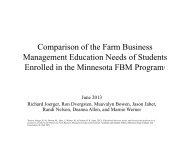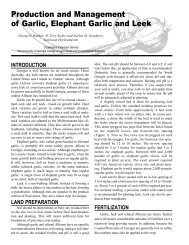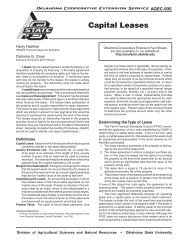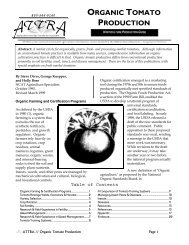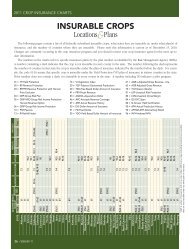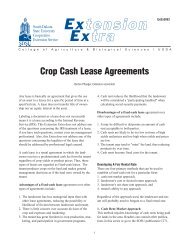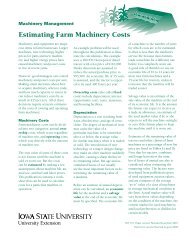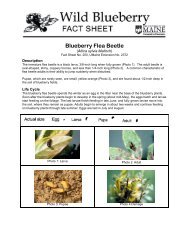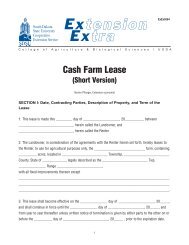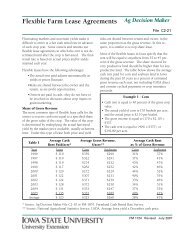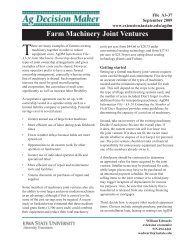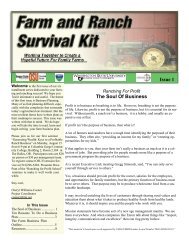Worksheet 1. Input Information
Worksheet 1. Input Information
Worksheet 1. Input Information
You also want an ePaper? Increase the reach of your titles
YUMPU automatically turns print PDFs into web optimized ePapers that Google loves.
EC-712 · Measuring & Analyzing Farm Financial Performance<br />
Purdue Extension · Knowledge to Go<br />
<strong>Worksheet</strong> <strong>1.</strong> <strong>Input</strong> <strong>Information</strong><br />
Schedule F Data<br />
Cost of livestock sold (Schedule F, line 2)<br />
Gross income (Schedule F, line 11)<br />
Depreciation (Schedule F, line 16)<br />
Mortgage interest (Schedule F, line 23a)<br />
Other interest paid (Schedule F, line 23b)<br />
Total expenses (Schedule F, line 35)<br />
Taxable Year:<br />
A<br />
B<br />
C<br />
D<br />
E<br />
F<br />
Balance Sheet Beginning Ending<br />
Balance sheet date<br />
Cash G M<br />
Total current farm assets H N<br />
Total current farm liabilities I O<br />
Prepaid expenses J P<br />
Accrued interest K Q<br />
Farm accounts payable and other accrued expenses L R<br />
Total farm assets<br />
S<br />
Total farm liabilities<br />
T<br />
Owner equity [S-T]<br />
U<br />
Miscellaneous Data<br />
Breeding stock sales (Form 4797)<br />
Number of operators and employees (annual full-time equivalent)<br />
Family living expenses & taxes (all families supported by the farm) 1<br />
Net Farm Income<br />
Gross revenues [A+B+V+(N-M-P)-(H-G-J)]<br />
Operating expenses [A+F-C-(D+E)+(R-L)+(J-P)]<br />
EBITDA 2 [Y-Z]<br />
Interest expense [D+E+(Q-K)]<br />
Net farm income from operations 3 [AA-AB-C]<br />
V<br />
W<br />
X<br />
Y<br />
Z<br />
AA<br />
AB<br />
AC<br />
1<br />
Enter $0 if all the owner-operator's compensation is included as wages in total expenses in item F above.<br />
Enter actual or estimated family living expenses and income taxes if a sole proprietorship.<br />
Enter owner withdrawals from the business for family living expenses and income taxes if a partnership or similar entity.<br />
This number is used to approximate the value of unpaid family labor and management.<br />
2<br />
Earnings before interest, income tax, depreciation, and amortization expenses.<br />
3<br />
Exclude large, unusual and infrequent gains or losses which are not recurring, such as the sale of land.<br />
Net farm income from operations is EBITDA - interest expenses - depreciation and is calculated on a pre-income tax<br />
basis.<br />
Purdue University Cooperative Extension Service · 2010
EC-712 · Measuring & Analyzing Farm Financial Performance<br />
Purdue Extension · Knowledge to Go<br />
<strong>Worksheet</strong> 2. Financial Position and Performance Ratios 1<br />
Profitability Your Farm Benchmark Strong/Weak<br />
Return on Assets [(AC+AB-X)÷S]*100<br />
Return on Equity [(AC-X)÷U]*100<br />
Operating Profit Margin Ratio [(AC+AB-X)÷Y]*100<br />
Liquidity<br />
Current Ratio [N/O]<br />
Working Capital/Gross Revenues Ratio [(N-O)÷Y]*100<br />
Solvency<br />
Debt-to-Asset Ratio [T÷S]*100<br />
Debt-to-Equity Ratio [T÷U]*100<br />
Financial Efficiency<br />
Asset Turnover Ratio [Y÷S]*100<br />
Revenue per Full-Time Laborer<br />
Operating Expense Ratio [Z÷Y]*100<br />
Depreciation Expense Ratio [C÷Y]*100<br />
Interest Expense Ratio [AB÷Y]*100<br />
Net Farm Income Ratio [AC÷Y]*100<br />
1 Alphabetical items in parentheses or brackets in the left-hand column refer to <strong>Worksheet</strong> <strong>1.</strong><br />
Purdue University Cooperative Extension Service · 2010
EC-712 · Measuring & Analyzing Farm Financial Performance<br />
Purdue Extension · Knowledge to Go<br />
<strong>Worksheet</strong> 3. Repayment Capacity Ratios and Measures<br />
Capital Debt Repayment Capacity and Margin, and Replacement Margin<br />
Net farm income from operations (Item AC, worksheet 1) 1<br />
Off-farm income 1 2<br />
Interest expense on term debt 2 (Item AB, worksheet 1, minus operating interest) 3<br />
Depreciation (Item C, worksheet 1) 4<br />
Family expenses, income taxes, etc. 3 5<br />
Capital debt repayment capacity [(1+2+3+4)-5] 6<br />
Principal on term debts and capital leases 7<br />
Unpaid operating debt from a prior period (carryover loss) 8<br />
Capital debt repayment margin [6-(3+8+9)] 9<br />
Cash used for capital replacement (or a replacement allowance) 4 10<br />
Replacement margin [9-10] 11<br />
Term Debt and Capital Lease Coverage Ratio [6÷(3+7+8)] 12<br />
Replacement Margin Coverage Ratio [6÷(3+7+8+10)] 13<br />
Estimated amount of additional term debt the replacement margin calculated above could service? 5<br />
Estimated years to repay term debt 14<br />
Estimated Interest rate available on new term debt for the term entered on line 20 15<br />
Amortization factor 16<br />
Additional term debt the margin would service [11÷16] 17<br />
1 Include gross off-farm income received by family members used to support family living or farming activities.<br />
2 Enter amount of interest paid on term debt if different from mortgage interest reported on the tax return.<br />
3 The amount on Line X, <strong>Worksheet</strong> <strong>1.</strong><br />
4 The amount of cash used for down payments or "boot" when making capital purchases. Do not include cash<br />
financed with loans. If the actual amount of cash used for capital replacement is zero or abnormally low<br />
use a number that reflects the average amount of cash used for capital replacement over the last five years.<br />
5<br />
This assumes the calculated replacement margin will recur every year during the repayment period.<br />
Purdue University Cooperative Extension Service · 2010
EC-712 · Measuring & Analyzing Farm Financial Performance<br />
Purdue Extension · Knowledge to Go<br />
<strong>Worksheet</strong> 4. Assessing the Effect of a Change on the Rates of Return<br />
Description of proposed changes:<br />
Financial Data 1 Actual Projected 2 Projected 2 Projected 2<br />
1 Gross Revenues (Item Y)<br />
2 Fixed Costs 3 (Items C+X+AB)<br />
3 Variable Costs 4 (Item Z)<br />
4<br />
Net Income after family living<br />
expenses and income taxes (1-2-3)<br />
5 Total Farm Assets (Item S)<br />
6 Owner Equity (Item U)<br />
7 Interest Expense (Item AB)<br />
Calculations<br />
A Operating Profit Margin [(4+7)/1]<br />
B Asset Turnover Ratio [1/5]<br />
C Return on Assets [A*B]<br />
D Interest Cost Adjustment [ 7/5 ]<br />
E Financial Structure [ 5/6 ]<br />
F Return on Equity [(C-D)*E)]<br />
1<br />
Alphabetical items in parentheses or brackets refer to worksheet <strong>1.</strong><br />
2<br />
In assessing proposed changes, it is best to consider one proposed change at a time. Enter your estimates for<br />
for the projected revenues and costs for your total farm after implementing the proposed change in this column.<br />
3<br />
Depreciation, interest, family living and income tax expenses. These costs do not vary directly with the level of<br />
production, If a more precise estimate is desired, include the insurance and property tax expenses reported<br />
on IRS Form 1040 Schedule F in fixed costs and deduct them from variable costs on line 3.<br />
4<br />
Variable costs are costs which vary with the level of production. For the amounts shown in the Actual column,<br />
variable costs are assumed to be total operating expenses from item Z on <strong>Worksheet</strong> <strong>1.</strong> If wages and salaries<br />
actually paid to the owner-operator of the farm are included in these expenses deduct these labor expenses<br />
from total operating expenses in item Z on <strong>Worksheet</strong> 1 to arrive at variable costs for line 4. Make sure that<br />
the wages and salaries deducted here are added to fixed costs on line 2.<br />
Purdue University Cooperative Extension Service · 2010
EC-712 · Measuring & Analyzing Farm Financial Performance<br />
Purdue Extension · Knowledge to Go<br />
<strong>Worksheet</strong> 5. Determining Breakeven Gross Revenues<br />
Financial Data 1<br />
1 Fixed Costs 2<br />
2 Variable Costs 3<br />
3 Gross Revenues<br />
Actual<br />
10% Lower<br />
Fixed Costs<br />
10% Lower<br />
Variable Costs<br />
Calculations<br />
A Variable Costs per $ of Revenue 4 (2÷3)<br />
B Contribution Margin per $ of Revenue 5 (<strong>1.</strong>0-A)<br />
C Breakeven Revenue 6 (1 ÷ B)<br />
D Breakeven Revenue + Additional Needs 7 [(1+Needs)÷B]<br />
1 The financial data is copied from <strong>Worksheet</strong> 4.<br />
2 Costs that do not vary with the production level production. These costs are the same as the fixed costs in<br />
<strong>Worksheet</strong> 4.<br />
3 Costs that vary with the production level. These costs are the same as the variable costs in <strong>Worksheet</strong> 4.<br />
4 The proportion of revenues needed to cover variable costs is determined at the breakeven point.<br />
5 The term contribution margin refers to the dollars of revenue available to pay fixed costs.<br />
6 The size of business at which total revenues cover total fixed and variable costs.<br />
7 This breakeven point recognizes that there is a need for funds beyond the payment of expense items. In addition to<br />
the fixed and variable costs included in Item D, this breakeven point includes the additional funds needed for annual<br />
principal payments on noncurrent debts, cash needed for unpaid operating debt from a prior period, and cash used<br />
for capital replacement. Sum the amounts on lines 7, 8, and 10 on <strong>Worksheet</strong> 3.<br />
Purdue University Cooperative Extension Service · 2010



